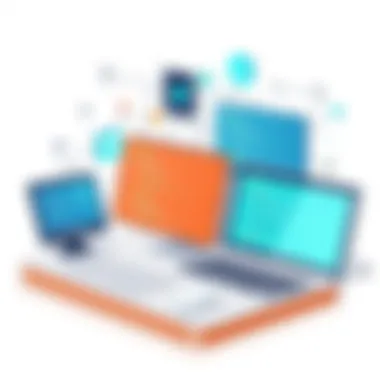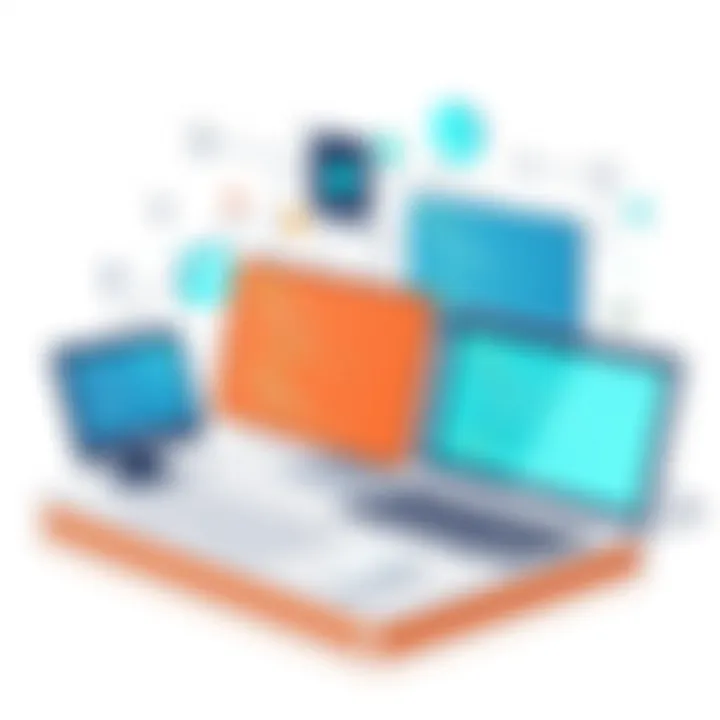Top Mobile Device Management Solutions of 2021 Reviewed


Intro
The landscape of Mobile Device Management (MDM) has evolved significantly over the years, with 2021 standing out as a pivotal year filled with advancements and adaptations in response to the chaotic disruptions caused by the pandemic. As organizations shifted towards remote work and relied heavily on mobile technology, the importance of robust MDM solutions became more apparent than ever. This article aims to provide a thorough evaluation of the leading MDM solutions from 2021, dissecting their features and analyzing their effectiveness in catering to various business needs.
Mobile Device Management plays a key role in ensuring that a company's devices are secure, compliant, and appropriately managed. With the rise of Bring Your Own Device (BYOD) policies and an increase in cyber threats, MDM provides essential tools for IT professionals tasked with safeguarding sensitive data while enabling productivity.
In this article, we will cover the essential features and benefits of various MDM platforms. We will also draw comparisons between these solutions and explore their pricing models to give insights into which option might best suit your organization's requirements. Understanding these aspects will not only help in making informed choices but also in optimizing the overall security and efficiency of device management in a business context.
Let us now delve deep into the key features and benefits associated with the most popular MDM solutions offered in 2021.
Intro to Mobile Device Management
In today's fast-paced digital landscape, managing mobile devices has become a cornerstone for organizations aiming to operate at peak efficiency. Mobile Device Management, commonly referred to as MDM, encompasses a suite of administrative tools and strategies designed to secure, monitor, and manage mobile devices efficiently. With the proliferation of smartphones, tablets, and laptops in workplaces, understanding MDM is essential for making informed decisions regarding device strategies.
The crux of this discussion centers around a few specific elements. First, there’s defining what MDM truly encompasses. This includes everything from basic functionalities like remote wiping of data to more advanced features like application management and policy enforcement. The benefits of adopting an MDM solution are manifold. Not only does it enhance security by ensuring only authorized users can access sensitive data, but it also allows for significant cost savings through improved efficiency and reduced downtime.
Considerations for organizations can vary widely based on their size, industry, and specific needs. Small businesses may prioritize budget-friendly solutions with essential features, while larger enterprises might seek comprehensive systems that integrate seamlessly with existing IT infrastructure.
"As devices continue to flood the market, managing them efficiently with the right solutions is no longer optional but necessary for the modern enterprise."
Additionally, MDM plays a vital role in enforcing compliance with industry regulations, which is crucial in maintaining customer trust and safeguarding sensitive information. The changing landscape of work, especially with remote and hybrid models becoming the norm, only accentuates the need for robust MDM solutions.
The following sections will elaborate on the essentials of MDM, its importance in modern enterprises, key features to look out for, and a comprehensive review of the leading solutions available in 2021.
Key Features of Effective Solutions
In the ever-evolving landscape of technology, it's paramount that companies employ robust Mobile Device Management (MDM) solutions. The efficiency of MDM solutions hinges significantly on key features that streamline device control, enhance security, and provide management capabilities. As businesses of all shapes and sizes grapple with the integration of mobile devices into their ecosystems, understanding the elements that make MDM solutions effective becomes essential. This section not only highlights the main features but also underscores their benefits and considerations.
Device Enrollment and Configuration
The first step in implementing an MDM solution is device enrollment and configuration. This feature acts as the gateway for organizations to seamlessly add devices to their network. An efficient enrollment process saves valuable time and minimizes headaches down the line. For example, automated enrollment methods, such as Apple's Device Enrollment Program (DEP) or Android Zero-Touch Enrollment, allow devices to be configured without heavy manual intervention. Organizations can pre-configure policies and applications that will be automatically installed once the device is activated, ensuring that employee devices are business-ready right out of the box.
Moreover, effective configuration should support batch enrolments. This is essential for larger enterprises that handle hundreds or thousands of devices. It reduces the complexity involved in setting up multiple devices individually, thereby enabling administrators to focus on more vital tasks.
Application Management Capabilities
Application management is another cornerstone of effective MDM solutions. The ability to centrally manage applications contributes to not only the security but also to the efficiency of operations. Companies can push needed applications to employee devices and remove unauthorized or non-compliant apps remotely. This ensures that users have access to necessary tools while preventing potential security breaches.
It's also crucial for MDM solutions to offer app whitelisting and blacklisting features. By controlling which apps can be installed, businesses can dodge many pitfalls associated with rogue software that could compromise data security. Many leading MDM solutions provide comprehensive app catalogs or integration with third-party app stores, allowing for a wider selection of applications while ensuring compliance with organizational policies.
Security and Compliance Features
Security cannot be overstated in today’s digital age. The repercussions of data breaches can be catastrophic; thus, MDM solutions must possess strong security capabilities. This means integrating features such as remote wiping, data encryption, and secure connection protocols. A reputable MDM solution enables administrators to remotely wipe devices in case they are lost or stolen, ensuring that sensitive organizational data does not land in the wrong hands.
Moreover, compliance is also a significant concern for many industries. MDM solutions with built-in compliance monitoring can help organizations adhere to regulations like GDPR or HIPAA, which is crucial to protecting both user data and company reputation. Thus, ensuring that the chosen MDM solution offers robust logging and reporting capabilities can provide peace of mind that regulations are being met.
User Experience and Support Systems
Finally, the user experience and the support systems offered by MDM solutions play a vital role in their effectiveness. A seamless interface and straightforward user navigation can significantly reduce friction for employees when adapting to new policies or systems.
Additionally, support is essential for troubleshooting and resolving issues that may arise post-implementation. A quality MDM solution should have accessible support channels—whether through documentation, online chats, or dedicated support staff—to assist users in overcoming hurdles without stalling productivity. Furthermore, training and onboarding resources tailored for employees often enhance adoption rates across an organization.
"An intuitive user experience paired with robust support mechanisms can be the difference between successful deployment and a chaotic rollout."


Comprehensive Review of Top Solutions
A comprehensive review of Mobile Device Management (MDM) solutions is crucial in today’s fast-paced business landscape. With the increasing dependence on mobile devices for both personal and work-related tasks, organizations are tasked with safeguarding sensitive data and maintaining operational efficiency. By examining top MDM solutions, companies can ascertain which tools best fit their unique requirements, ensuring a seamless integration process while bolstering security protocols and device management strategies.
Overview of Leading Solutions
When evaluating MDM solutions, it's important to consider how each option aligns with the organizational goals. Leading solutions in the market typically offer a robust suite of features, designed to enhance security, user experience, and operational efficiency. Some of the top players in the field are VMware Workspace ONE, Microsoft Intune, Cisco Meraki, and Jamf Pro.
- VMware Workspace ONE: Known for its hybrid architecture, it brings together UEM (Unified Endpoint Management) tools for managing apps and devices.
- Microsoft Intune: This solution integrates deeply with Microsoft 365, offering a familiar interface for many organizations.
- Cisco Meraki: Pairing networking and MDM, this solution is celebrated for its intuitive dashboard and powerful security protocols.
- Jamf Pro: A go-to choice for Apple-focused environments, Jamf Pro excels in managing Mac and iOS devices, emphasizing user experience.
Evaluating these solutions against criteria such as scalability, ease of use, and support can provide valuable insights into their fit for diverse organizational setups.
Solution A: Features, Pros, and Cons
Solution A: VMware Workspace ONE
Features:
- Unified endpoint management for a wide range of devices.
- Intuitive interface for admins and users alike.
- Support for app lifecycle management.
Pros:
- Flexibility in deployment options (cloud or on-premises).
- Strong analytics capabilities for tracking device performance.
Cons:
- Higher learning curve for new administrators.
- Costs can add up with advanced features.
Solution B: Features, Pros, and Cons
Solution B: Microsoft Intune
Features:
- Integration with Azure Active Directory.
- Native support for Android and iOS devices.
Pros:
- User-friendly interface that teams can quickly adapt to.
- Seamless integration with existing Microsoft products, enhancing productivity.
Cons:
- Limited features for non-Microsoft ecosystems.
- Conditional access policies can be complex to manage.
Solution C: Features, Pros, and Cons
Solution C: Cisco Meraki
Features:
- Cloud-based management with real-time dashboard analytics.
- Device and network management in a single pane of glass.
Pros:
- Excellent security features, maintaining compliance with regulatory standards.
- Strong customer support channels available.
Cons:
- Licensing structure may seem convoluted.
- Some users report performance issues with mobile app management.
Solution D: Features, Pros, and Cons


Solution D: Jamf Pro
Features:
- Tailored specifically for Apple device ecosystems.
- Comprehensive application management and deployment tools.
Pros:
- Exceptional management capabilities for macOS and iOS.
- Strong community support and resources available.
Cons:
- Limited support for non-Apple devices may alienate diverse environments.
- Higher costs particularly for smaller organizations.
In summation, the comprehensive review of top MDM solutions offers organizations a clearer lens into not just the functionalities of each product, but also their suitability based on unique operational goals. Each solution, while offering specific benefits, comes with its own set of limitations. Therefore, the assessment process is critical in achieving an optimal match that drives efficiency and enhances security measures in the device management landscape.
Implementation Considerations for Solutions
Determining the right Mobile Device Management (MDM) solution for an organization involves more than just evaluating features. It's crucial to delve into the implementation considerations, as these factors can significantly influence the overall effectiveness and utility of the chosen solution. The way an MDM solution is implemented affects not only the initial deployment but also the long-term usability and adaptation of the system within an organization.
Assessing Organizational Needs
Understanding the unique needs of your organization is the first step in implementing a successful MDM solution. This involves taking stock of various elements, such as the number of devices in use, the types of operating systems that need support, and the specific security requirements that your organization must adhere to.
Start by asking these probing questions:
- How many devices are we managing?
- What types of applications are primarily used?
- Are these devices managed by staff or do we have a bring-your-own-device policy?
- What compliance regulations apply to our industry?
Crafting a comprehensive picture of your organizational needs allows for more precise targeting of MDM features that will matter the most. For instance, a healthcare provider may prioritize strict compliance and security, while a retail business may focus more on ease of use and application management. Addressing these aspects can maximize the solution’s adoption rate among employees, reducing resistance and enhancing overall efficiency.
Integration with Existing Systems
One common pitfall during MDM implementation is the failure to adequately consider how new solutions will fit into existing systems. Integration can make or break the effectiveness of MDM software. Organizations often deploy a variety of software and tools that must work seamlessly with the new MDM system. Here are a few key points to ensure a successful integration:
- Identify existing software platforms that will need to interoperate with the MDM solution, such as email systems, file sharing services, and company portals.
- Check for APIs that can facilitate smooth data exchange between systems, ensuring that information flows freely.
- Conduct pilot tests with a subset of users to gauge potential issues before full rollout.
By prioritizing integration, organizations can avoid a clunky experience that leads to frustration and inefficiency. A haywire integration could turn even the best MDM solutions into a headache.
Budgeting for Deployment
Lastly, an often-overlooked factor is accurate budgeting for MDM deployment. It is not just about the initial licensing costs; organizations need to consider various other expenses that can creep up during implementation:
- Training Costs: Staff may need training to adapt to the new system first before they can use it effectively.
- Ongoing Maintenance: Subscription fees, updates, and support services can accumulate over time.
- Resource Allocation: Time and personnel must be allocated not only for setup but also for ongoing management.
Careful budgeting allows for clearer visibility into total costs associated with the MDM solution. It offers the opportunity to take a hard look at potential returns on investment by examining how well managed devices can lead to increased productivity and reduced risks from security breaches.
"A well thought-out implementation approach leads to maximum gain with minimal headache."
In summary, the pathway to an effective MDM implementation requires a deep understanding of your organization, strategic integration with existing technologies, and precise budgeting to cover all aspects of deployment. By focusing on these areas, businesses can significantly enhance their mobile device management capabilities, supporting overall growth and ensuring a secure digital workplace.
User Feedback and Experiences
Understanding user feedback and experiences is paramount when evaluating Mobile Device Management (MDM) solutions. These perspectives offer a glimpse into the real-life applications and effectiveness of the technology, shedding light on areas of strength and those needing improvement. It’s not merely about features and specifications; it's about how these solutions fare in day-to-day operations and their effect on organizational productivity.
Users from multiple sectors provide invaluable insights into how MDM solutions meet their needs. By diving into their experiences, IT professionals and decision-makers can more precisely assess which tools can genuinely enhance security, compliance, and usability. This aspect helps organizations not only identify capable solutions but also recognize potential pitfalls that could hinder operational workflows.
Real-World User Experiences


In the real world, users of MDM solutions often highlight specific aspects that either bolster their operations or sprawl challenges. Many organizations report that ease of deployment is a crucial factor. For instance, a company may implement VMware Workspace ONE and find it straightforward to configure and manage. Similarly, Microsoft Intune often comes up in conversations where users appreciate its seamless integration within existing Microsoft ecosystems.
However, experiences are not universally positive. Some users have noted frustrations, particularly around the learning curve associated with more complex systems like IBM MaaS360. The initial setup can be daunting, and without appropriate technical support, organizations may feel overwhelmed.
Common feedback across many platforms includes:
- Interface Usability: How intuitive is the dashboard? Can IT staff navigate it easily?
- Customer Support: Is technical assistance responsive and effective?
- Updates and Maintenance: Are patches and updates rolled out smoothly without disrupting service?
"MDM solution implementation can feel like a double-edged sword; it can either streamline your operations or turn into a tangled web of complications," a user once pointed out on Reddit.
Common Challenges Faced
It's a mixed bag when it comes to user feedback, and challenges do arise frequently. One predominant issue reported by various organizations is the challenge of device compatibility. While many MDM solutions advertise broad system support, users often find that certain devices face restrictions, leading to dissatisfaction.
Another point of contention is user privacy concerns. Employees may question how their personal data is handled, which can cause friction between the company and its workforce. This skepticism can complicate implementation stages and ultimately hinder overall success. Additionally, some users cite the absence of granular control over features as a hindrance, especially when tailored solutions are needed for diverse departmental needs.
A few more prevalent challenges include:
- Scalability issues: As organizations grow, their tech needs may outstrip what some MDM solutions can handle efficiently.
- Training requirements: Staff may require significant training time, making rollout more prolonged than projected.
- Budget constraints: Especially for small businesses, the costs associated with advanced MDM solutions can be prohibitive, especially given the uncertain return on investment.
In summary, real-world experiences and user feedback serve as valuable nuggets of wisdom in the evaluation process of MDM solutions. They provide a window into the operational efficacy and allow potential buyers to approach their choices with a well-rounded understanding of what to expect. By tapping into these insights, businesses can avoid common pitfalls and make more informed decisions that integrate seamlessly into their existing structures.
Future Trends in Mobile Device Management
As mobile devices continue to dominate the business landscape, keeping a watchful eye on upcoming trends in Mobile Device Management (MDM) becomes essential for organizations. Future trends not only shape how organizations will manage their devices but also influence the overall effectiveness of their mobile strategies.
Emerging Technologies Shaping
The technological realm is constantly evolving, and several innovations are reshaping how MDM solutions function. Close examination of these technologies is vital for organizations aiming to stay ahead of the curve. First and foremost, Artificial Intelligence (AI) and machine learning are carving out significant niches in MDM. These tools enable automated decision-making, alleviating the burden on IT departments to manage devices manually. For example, AI-driven analytics can pinpoint anomalies and potential security threats much faster than human intervention, enhancing overall security posture.
Another game-changing tech is Internet of Things (IoT) integration. With workplaces increasingly populated by smart devices, MDM solutions are shifting from handling only traditional mobile devices to catering for a wide array of connected gadgets, from wearables to smart appliances. Having a unified system ensures all devices follow company protocols, thereby minimizing risks.
Moreover, the rise of 5G technology is another pivotal factor. Faster internet speeds and more reliable connectivity allow devices to communicate seamlessly, meaning MDM systems also need to keep up by offering real-time data access and improved device performance. The integration of blockchain technology is also becoming a talking point among MDM providers, particularly for its potential to enhance security and track changes in device ownership.
The Shift Towards Cloud-Based Solutions
In recent times, many organizations have recognized the tremendous benefits of cloud-based MDM solutions over on-premises setups. The shift towards the cloud brings with it several advantages that can't be overlooked. For one, cloud solutions offer scalability. As businesses grow, their MDM needs will likely expand, and cloud solutions can easily accommodate these shifts without hefty investments in hardware.
Cost-effectiveness is another key factor. With cloud MDM, organizations can often operate on a subscription model instead of incurring on-time costs associated with infrastructure upkeep. This flexibility allows organizations, both small and large, to allocate resources more efficiently.
Furthermore, cloud-based MDM solutions ensure that updates and security patches happen automatically, thereby reducing the workload for IT teams. Data recovery becomes more straightforward, and organizations can easily back up their data, mitigating risks related to device loss or theft.
Culmination
The significance of staying abreast of future trends in MDM cannot be overstated. As organizations continue adapting to a mobile-first approach, leveraging emerging technologies and cloud-based solutions will play a crucial role in shaping effective mobile strategies.
Keeping these elements in mind positions businesses to not only efficiently manage their mobile devices but also prep them for the hurdles that the future may present. Businesses that hesitate to adopt these trends risk overspending on outdated solutions and unwittingly exposing themselves to security vulnerabilities.
Finale: Selecting the Right Solution
When it comes to managing mobile devices within an organization, choosing the right Mobile Device Management (MDM) solution is not just a matter of preference; it's a pivotal decision that can significantly influence operational efficiency and security. The right MDM solution acts as the backbone of an organization's mobile management strategy, ensuring that devices are secure while also being user-friendly and efficient. Understanding the key elements involved in selecting an MDM solution is central to empowering businesses to make judicious choices that align with their unique requirements.
Evaluating long-term viability and support options is one essential aspect of this process. Organizations must consider how long a provider has been in the game and their reputation for reliability. A solution might look good on paper, but if the company backing it can’t be trusted to provide timely updates or support, then it’s a gamble that could end up costing more in the long run. Furthermore, assessing how adaptable the software is to potential future needs is crucial. The dynamic nature of technology means that today's cutting-edge features might become obsolete or less valuable tomorrow. Hence, investing in a solution that evolves with changing technological landscapes can safeguard the organization's investment.
"Security isn’t a product, but a process."
On the other hand, the essence of final recommendations for decision-makers hinges on clarity in defining organizational needs. This is where knowing what features are non-negotiable versus those that are simply nice-to-have comes into play. Targeted insights into necessary capabilities—such as data encryption, remote wipe functionality, and integration with existing systems—should guide decision making. Involving stakeholders from relevant departments—not just IT—will ensure that the selected MDM solution addresses the broad spectrum of needs across different functional areas.
Lastly, fostering a culture of continuous evaluation after the implementation of the MDM solution is vital. Regular performance reviews can help pinpoint areas for improvement, ensure the solution's capabilities are being fully utilized, and adapt to any new challenges that arise. Keeping a vigilant eye on user feedback is equally crucial; after all, end users are the ones who will directly interact with the solution daily.
By taking into account the long-term viability, organizational requirements, and maintaining open channels for feedback, decision-makers can minimize the risks associated with MDM solutions, ultimately choosing the right tool that meets both current and future needs in a rapidly evolving mobile landscape.



